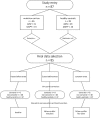Longitudinal cognitive biomarkers predicting symptom onset in presymptomatic frontotemporal dementia
- PMID: 29627938
- PMCID: PMC5990575
- DOI: 10.1007/s00415-018-8850-7
Longitudinal cognitive biomarkers predicting symptom onset in presymptomatic frontotemporal dementia
Abstract
Introduction: We performed 4-year follow-up neuropsychological assessment to investigate cognitive decline and the prognostic abilities from presymptomatic to symptomatic familial frontotemporal dementia (FTD).
Methods: Presymptomatic MAPT (n = 15) and GRN mutation carriers (n = 31), and healthy controls (n = 39) underwent neuropsychological assessment every 2 years. Eight mutation carriers (5 MAPT, 3 GRN) became symptomatic. We investigated cognitive decline with multilevel regression modeling; the prognostic performance was assessed with ROC analyses and stepwise logistic regression.
Results: MAPT converters declined on language, attention, executive function, social cognition, and memory, and GRN converters declined on attention and executive function (p < 0.05). Cognitive decline in ScreeLing phonology (p = 0.046) and letter fluency (p = 0.046) were predictive for conversion to non-fluent variant PPA, and decline on categorical fluency (p = 0.025) for an underlying MAPT mutation.
Discussion: Using longitudinal neuropsychological assessment, we detected a mutation-specific pattern of cognitive decline, potentially suggesting prognostic value of neuropsychological trajectories in conversion to symptomatic FTD.
Keywords: Biomarkers; Cognition; Familial; Frontotemporal dementia; Longitudinal; Neuropsychological assessment; Presymptomatic.
Conflict of interest statement
Conflicts of interest
LCJ, JLP, LvA, LHM, LDK, ELvdE, EGPD, RT, RvM, JvS, EvdB, JMP report no conflicts of interest.
Ethical standard
All procedures performed in studies involving human participants were in accordance with the ethical standards of the institutional and national research committee, and with the 1964 Helsinki declaration and its later amendments or comparable ethical standards.
Informed consent
Informed consent was obtained from all individual participants included in the study.
Figures


References
MeSH terms
Substances
Grants and funding
LinkOut - more resources
Full Text Sources
Other Literature Sources
Molecular Biology Databases
Miscellaneous

